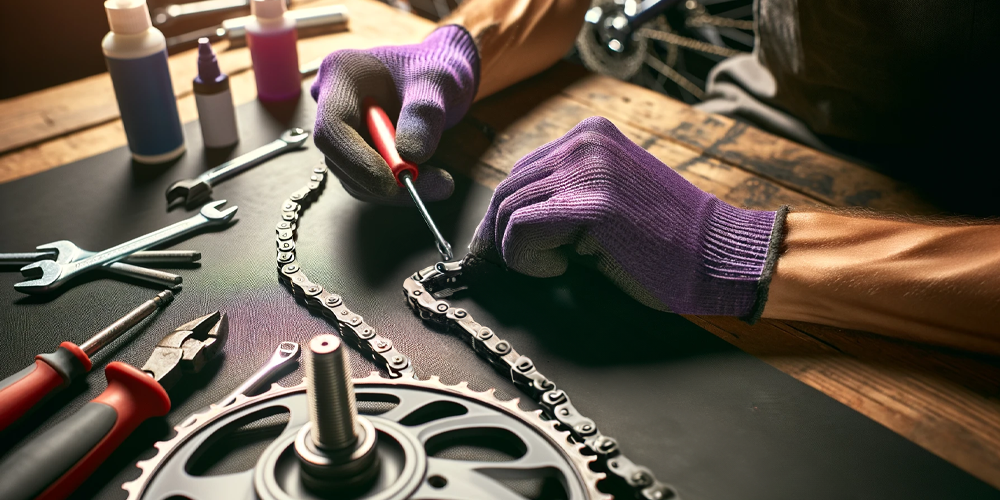The bike chain, although small and often overlooked, plays a crucial role in the performance and efficiency of your bike. A well-maintained chain can make the difference between a smooth, efficient ride and a tiring struggle. For cyclists who want to get the most out of their equipment, expert bike chain maintenance is therefore essential.
The Importance of Chain Maintenance
A study by Smith et al. (2020) in the “Journal of Mechanical Engineering” shows that a well-lubricated and clean bike chain can reduce friction by up to 50% compared to a neglected chain. This reduction in friction not only leads to a noticeable improvement in ride efficiency but also extends the lifespan of all drivetrain components. There are also numerous other advantages to good and regular chain maintenance:
- Extended lifespan of components: Dirt and sand act like sandpaper on the chain, chainrings, and cogs, leading to quicker wear. Regular cleaning and lubrication minimize this effect, thus extending the life of the chain and associated components.
- Reduced maintenance costs: Over time, the costs of replacing worn parts like chains, chainrings, and cassettes can be significant. A well-maintained chain reduces the frequency of replacing these parts, saving money in the long run.
- Better shifting performance: A clean and properly lubricated chain ensures smooth and precise shifting. This not only improves the riding experience but also reduces the likelihood of shifting errors that can lead to wear or damage to the drivetrain.
- Protection against corrosion: Regular lubrication protects the chain from rust and corrosion, especially when riding in wet or salty environments. This is particularly important for cyclists who ride in all weather conditions.
- Improved safety: A well-maintained chain reduces the risk of chain breakage or skipping during the ride, contributing to a safer ride, especially at high speeds or on challenging terrain.
Cleaning: The First Step to Optimal Performance
Regular cleaning of the chain is crucial to remove deposits, dirt, and sand that can damage the chain and gears. For effective cleaning, experts recommend using a special chain cleaning device, which immerses the chain in a bath of cleaning fluid while brushes and scrapers remove the dirt.
Preparation
- Materials: Prepare a chain cleaner (or mild detergent), a chain brush or an old toothbrush, a cloth, water, and optionally, a special chain cleaning device.
- Positioning: Position the bike so that you can easily access the chain. A bike stand is ideal but not necessary.
Cleaning Steps
- Remove coarse dirt: Start by wiping the chain with a dry cloth to remove coarse dirt and old lubricant. Hold the cloth around the chain while you turn the pedals backward.
- Use of the chain cleaning device (optional): If you have one, fill it with chain cleaner and attach it to your chain. Then, turn the pedals to run the chain through the device. This effectively removes dirt from all sides of the chain.
- Brushing: If you don’t have a chain cleaning device, apply the chain cleaner directly to the chain and use the brush or toothbrush to loosen dirt. Be sure to thoroughly scrub all sides of the chain, including the links and rollers.
- Rinsing: Rinse the chain with water to remove the loosened dirt and excess cleaner. When using a garden hose, ensure that the water pressure is low to prevent water from being forced into the bearings.
- Drying: Thoroughly wipe the chain with a clean cloth to remove as much water as possible. Then, allow the chain to air dry before applying new lubricant.
- Relubrication: Once the chain is completely dry, apply suitable lubricant to each link by turning the pedals backward and applying the lubricant to the inside of the chain. Wipe off excess lubricant to avoid dirt buildup.
The Choice of Lubricant
Choosing the right lubricant and applying it correctly is essential for the performance and longevity of the chain. Wax-based lubricants, for example, offer excellent protection in dry conditions and attract less dirt, while synthetic oils are better for wet conditions. A study by Andersen and colleagues (2021) highlights that regular application of appropriate lubricant can extend the lifespan of a bike chain by up to 40%.
The Right Lubrication Technique
Simply applying lubricant to the chain is not enough. For optimal lubrication, experts recommend applying lubricant directly to each link while the chain is slowly moved to ensure even distribution. Excess lubricant should then be removed to minimize dirt attraction. Precise application not only ensures a smooth ride but also prevents dirt buildup, which can further strain the chain.
Tips for Chain Cleaning
- Regularity: The frequency of cleaning depends on your riding habits. For regular riding in dirty or wet conditions, you should clean the chain more frequently.
- Protective measures: To protect the rest of the bike, you can cover the frame with a cloth to shield it from splashes of cleaning fluid.
- Care: Avoid aggressive chemicals that could damage rubber or plastic parts of your bike.
Wear Detection and Management
Regularly checking for chain wear is crucial for maintenance. Advanced wear can lead to inefficient power transfer and damage to the cogs and chainrings. Technically savvy cyclists use chain wear gauges to accurately assess the condition of their chain and replace it in a timely manner. Proactive chain replacement can significantly extend the lifespan of the entire drivetrain and reduce the need for costly repairs.
Create a training plan for triathlon, cycling, and running based on artificial intelligence with 2PEAK that adapts to your performance after each training session. Download the app and start revolutionizing your training.


